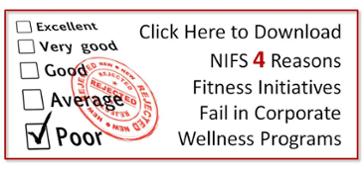 There’s been a lot in the media lately about wearable technology having a strong presence in corporate wellness. Employee wellness programs have provided a whole new market for some wearable manufacturers, and one research firm indicates that upwards of 13 million wearables could become part of employee wellness initiatives in the next five years.
There’s been a lot in the media lately about wearable technology having a strong presence in corporate wellness. Employee wellness programs have provided a whole new market for some wearable manufacturers, and one research firm indicates that upwards of 13 million wearables could become part of employee wellness initiatives in the next five years.
The Challenges with High Tech Wellness
This specific high-tech phenomenon is fairly new and relatively unresearched in terms of long-term effectiveness at helping adults make sustainable health behavior change. But technology in corporate wellness has been around for years and it has evolved to keep up with perceived wants and needs. Years (and I mean years) ago, we used to take health risk assessments (HRA) on paper. Then those moved to this thing called the internet. Eventually, we got “smart” feedback on those HRAs and our fingerstick data was integrated with our self-report HRA responses to create a profile.
Now we have web capacity to integrate with pedometers and other higher-tech wearables like Up® by Jawbone® and various products by Fitbit. The data syncs up to a company site where we can compete with our peers, and it links with our own tracking tools on our phones. We have access to a lot of information about our movement. Still, I wonder if data is really king when it comes to health behavior change. Are high-tech solutions enough to help someone move their own needle?
You probably have anecdotes where someone’s health was profoundly changed with the help of a wearable, an app, or some combination. You, like me, may also know stories where a wearable began an obsession with data and quickly sucked all the fun out of measuring the movement. So effectiveness may very well be in the arm of the wearer (so to speak). Still, there are definite limits to today’s tech solutions. Maybe someone will solve them down the line, but right now, as I see it, there are barriers on tech that limit potential impact on improving health. There’s a great outline of these limits in this Forbes article.
There are other issues with a high-tech-only solution that have come to light recently, as well. For example, while more and more boomers (who are still in your workforce) are adopting technology solutions in various areas of their lives, they still lag behind Gen X and Millennials in their rate of adoption. This article makes the case that boomers may be the demographic most likely to benefit from, and most willing to pay for health-related technology, but the market isn’t designing for them.
And while the technology certainly supports what seems to be the unquenchable thirst for data, there is still the tricky math involved in determining whether your employee wellness device translates to actual company savings on health care.
How High Touch Wellness Helps
When you look at the challenges identified in the Forbes article, many (dare I say all) of them can be worked through or even remedied by a human being with a brain and some capacity for nuance. And here’s where high-touch in corporate wellness steps up.
The right people powering your corporate wellness program should be
- Both capable of and passionate about helping your employees establish healthy goals and effective plans to achieve those goals.
- Compassionate motivators who have the right skills to nudge participants toward finding their own intrinsic motivation.
- Nuanced enough to know when to step in to provide a course correction when your employees stop engaging or when their efforts aren’t achieving the carefully crafted goals.
- Savvy at helping participants understand their data in a way that’s meaningful and impactful.
Using people in a high-touch capacity to bolster and back up your high-tech tools can be an effective way to help your employees achieve better health.


 My earliest memory of my biggest fear was around age seven or eight. I was playing in my backyard with my childhood best friend on the swing set. We were running around it trying to catch each other when I slipped and fell, cutting my arm. I didn’t even realize I was bleeding until my friend pointed it out to me. Immediately my heart started to race, palms began to sweat, and I quickly lost all the color in my face. The next thing I remember is my Mom and friend standing over me as I lay on the ground after passing out. Every encounter with blood after this episode only amplified this fear, often resulting in avoiding certain situations such as routine blood draws or even jobs that required me to be able to perform a finger stick cholesterol test to fitness center members. Finally, after living with this fear for over twenty years, I finally made up my mind that it was time to face it. What is the one big fear you have in your life? Are you ready to face it?
My earliest memory of my biggest fear was around age seven or eight. I was playing in my backyard with my childhood best friend on the swing set. We were running around it trying to catch each other when I slipped and fell, cutting my arm. I didn’t even realize I was bleeding until my friend pointed it out to me. Immediately my heart started to race, palms began to sweat, and I quickly lost all the color in my face. The next thing I remember is my Mom and friend standing over me as I lay on the ground after passing out. Every encounter with blood after this episode only amplified this fear, often resulting in avoiding certain situations such as routine blood draws or even jobs that required me to be able to perform a finger stick cholesterol test to fitness center members. Finally, after living with this fear for over twenty years, I finally made up my mind that it was time to face it. What is the one big fear you have in your life? Are you ready to face it? 
 Our staff is kicking off our annual Maintain Not Gain program at our client sites. This program is structured to help individuals maintain their weight through those months filled with tasty food and delicious treats that surround the holidays. As you gear up for the holiday parties and events stay on track by following our Free Workout Friday blog postings to keep your workouts on track. We aren’t saying you can’t enjoy the food, we just suggest proper portion sizes and that you don’t skip out on your workouts!
Our staff is kicking off our annual Maintain Not Gain program at our client sites. This program is structured to help individuals maintain their weight through those months filled with tasty food and delicious treats that surround the holidays. As you gear up for the holiday parties and events stay on track by following our Free Workout Friday blog postings to keep your workouts on track. We aren’t saying you can’t enjoy the food, we just suggest proper portion sizes and that you don’t skip out on your workouts! 
 Thanksgiving is almost here! That means it’s time to sign up for your local Turkey Trot, Drumstick Dash or your own personal Thanksgiving Day 5K! Studies have proven that your metabolism increases for several hours post-workout, so make a priority to squeeze in some exercise and boost your body’s calorie burning abilities before the big feast. If you do happen to be training for a 5K on Thanksgiving Day, see below for a sample training program that starts on Monday, 11/11. So today, we want you to go for a brisk walk because you need to pick up the pace on Monday!
Thanksgiving is almost here! That means it’s time to sign up for your local Turkey Trot, Drumstick Dash or your own personal Thanksgiving Day 5K! Studies have proven that your metabolism increases for several hours post-workout, so make a priority to squeeze in some exercise and boost your body’s calorie burning abilities before the big feast. If you do happen to be training for a 5K on Thanksgiving Day, see below for a sample training program that starts on Monday, 11/11. So today, we want you to go for a brisk walk because you need to pick up the pace on Monday!
 Even if I’m not taking a class with her she is always there for encouragement and to help me become the best I can be by educating me. She pushes me personally to be better than I knew I could be, and she stretches me way past my comfort zone! For her position, that’s a compliment! There isn’t a class I take that I don’t wake up the next day feeling it. She is all around a sweet person and really makes it a comfortable atmosphere to workout in. Since my last child was born last October I have lost close to 60 lbs! She has been there every step of the way cheering me on! I’m not the only one who feels this way either, we sure do love her!"
Even if I’m not taking a class with her she is always there for encouragement and to help me become the best I can be by educating me. She pushes me personally to be better than I knew I could be, and she stretches me way past my comfort zone! For her position, that’s a compliment! There isn’t a class I take that I don’t wake up the next day feeling it. She is all around a sweet person and really makes it a comfortable atmosphere to workout in. Since my last child was born last October I have lost close to 60 lbs! She has been there every step of the way cheering me on! I’m not the only one who feels this way either, we sure do love her!"


 How many times do you circle a parking lot looking for that perfect spot right in front of the door? It doesn’t matter if I am at the supermarket, a sporting event, a restaurant, or even the gym (sad, but true); I see people circling the lot like they’re in the Indy 500. As I get out of my car and walk to my destination, all I can do is ask myself, “Do they really think they are benefiting from parking in front of the door?”
How many times do you circle a parking lot looking for that perfect spot right in front of the door? It doesn’t matter if I am at the supermarket, a sporting event, a restaurant, or even the gym (sad, but true); I see people circling the lot like they’re in the Indy 500. As I get out of my car and walk to my destination, all I can do is ask myself, “Do they really think they are benefiting from parking in front of the door?” When you are exercising on an elliptical or stationary bike, it’s easy to go on auto-pilot and stay at the same easy to intermediate level that your body is used to. Next time you find yourself of one of these machines, try adding in some interval training! Intervals will make the heart rate jump, then allow for periods of recovery where the heart rate will fall, thus providing better conditioning for the cardiovascular system and burning more calories than the slower, steady-state cardio.
When you are exercising on an elliptical or stationary bike, it’s easy to go on auto-pilot and stay at the same easy to intermediate level that your body is used to. Next time you find yourself of one of these machines, try adding in some interval training! Intervals will make the heart rate jump, then allow for periods of recovery where the heart rate will fall, thus providing better conditioning for the cardiovascular system and burning more calories than the slower, steady-state cardio.